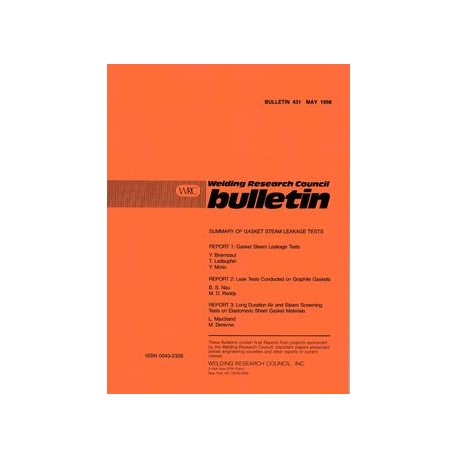Product successfully added to your shopping cart
Quantity
Total
There are 2 items in your cart. There is 1 item in your cart.
Total products $17.16
Total shipping To be determined
Total $17.16
New Reduced price!  View larger
View larger
 View larger
View larger WRC 431
M00000607
New product
WRC 431 Part 1: Summary of Gasket Steam Leakage Tests: Gasket Steam Leakage Tests; Part 2: Summary of Gasket Steam Leakage Tests: Leak Tests Conducted on Graphite Gaskets; Part 3: Summary of Gasket Steam Leakage Tests: Long Duration Air and Steam Screening Tests on Elastomeric Sheet Gasket Materials
Bulletin / Circular by Welding Research Council, 1998
Y. Birembaut, T. Ledauphin, Y. Morio; B. S. Nau, M. D. Reddy; L. Marchand, M. Derenne
In stock
More info
Full Description
Part 1: Summary of Gasket Steam Leakage Tests: Gasket Steam Leakage TestsThe three PVRC project reports presented in this Bulletin are concerned with elevated temperature sheet gasket performance in steam media. The steam media was an important factor for each of the Projects, thus setting them apart from previous PVRC gasket test programs. In addition, these projects were created as follow-up efforts to address questions arising out of MTI's Project No. 47 and subsequent PVRC and private gasket test projects. It is the purpose of this extended Foreword to provide the reader with additional background, references, and insights concerning the work and tests reported by this Bulletin.
A major aspect of the MTI and PVRC work was the characterization of the long-term performance and thermal degradation of fiber reinforced elastomer bounds gaskets and flexible graphite sheet gaskets. However, those test programs were conducted with still air in the case of ATRS relaxation tests and with nitrogen or helium as contained media with still air surrounding the gasket outside diameter in the case of HOTT tests. Subsequent PVRC Projects developed the AHOT test as an extension of the HOTT test that considers longer aging times, and the ARLA test as a more sophisticated extension of the ATRS relaxation test. Again, these tests were conducted with hot gases and the question remained: What about long-term gasket performance in a steam media? To address this question the PVRC Committee on Bolted Flanged Connections initiated Projects 92-24, 26, and 27 to investigate the effect of steam media.
Part 2: Summary of Gasket Steam Leakage Tests: Leak Tests Conducted on Graphite Gaskets
Steam leak tests were conducted on "Grafoil" gaskets supplied by PVRC. The BHRG steam joint test facility was used to generate the specified steam temperature and pressure conditions. The test facility is described in Appendix A. Details of gaskets, flanges, bolting and fluid conditions used in tests are presented in Section 2. Section 3 contains a brief description of the test procedure and Section 4 reviews results.
Part 3: Summary of Gasket Steam Leakage Tests: Long Duration Air and Steam Screening Tests on Elastomeric Sheet Gasket Materials
Gasket bolted flanged connections are everywhere in the industry. Preventing unacceptable leaks and ensuring safe operation are the most important and difficult requirements these gasketed joints have to fulfill during their service life under elevated temperature conditions. Over the years, this task has become even more difficult to achieve due to the replacement of asbestos based gaskets and the reduction of flange emissions imposed by more stringent regulations.
In North American, a substantial research effort has been dedicated, since the mid 1980's, to the characterization of gasket performance at elevated temperature. As the result, a first gasket qualitification protocol for predicting long-term service temperature of elastomeric sheet gasket materials was published in 1990. Since then, the research effort has been continuously pursued to improve the confidence level of the long-term temperature predictions. The present test program, PVRC Project No. 92-94, was completed to study the change in the properties of six different elastomer bound sheet gasket materials subjected to temperature exposure for periods of up to 1 year. For this program, mechanical test fixtures were used to age circular gasket specimens in ovens. Tests were performed in an air atmosphere at temperatures ranging from 420F (216C) up to 700F (371C), or in a low pressure steam atmosphere at 450F (232C). Through the results of these tests, a better understanding of the long-term effect of thermal degradation on the properties of elastomeric sheet gasket materials was achieved. It was also found that the change of a gasket property, such as leak rate, can be accurately represented and predicted by the Arrhenius model. Form this new knowledge, an improved qualification protocol based on the obtainment of the thermal endurance graph of a sheet gasket material is proposed for the extrapolation of the long-term service temperature.



